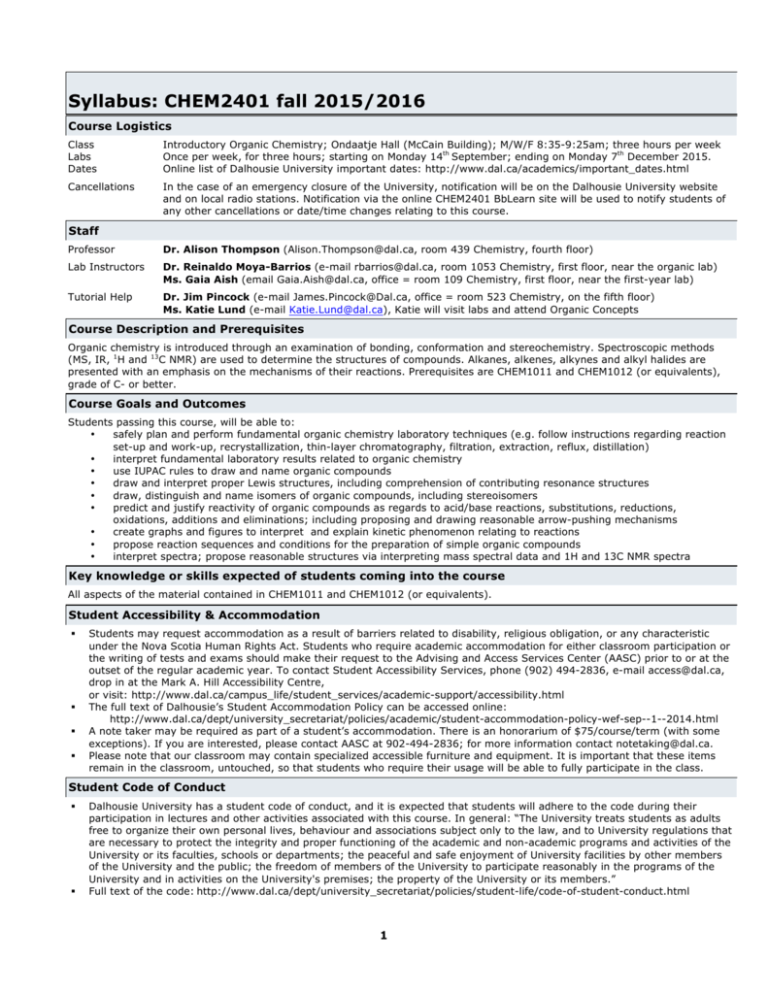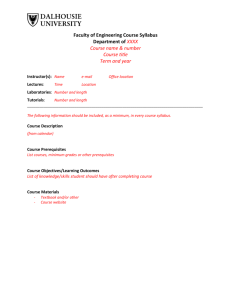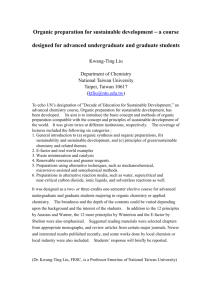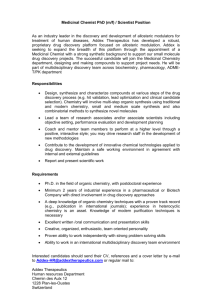
Syllabus: CHEM2401 fall 2015/2016
Course Logistics
Class
Labs
Dates
Introductory Organic Chemistry; Ondaatje Hall (McCain Building); M/W/F 8:35-9:25am; three hours per week
Once per week, for three hours; starting on Monday 14th September; ending on Monday 7th December 2015.
Online list of Dalhousie University important dates: http://www.dal.ca/academics/important_dates.html
Cancellations
In the case of an emergency closure of the University, notification will be on the Dalhousie University website
and on local radio stations. Notification via the online CHEM2401 BbLearn site will be used to notify students of
any other cancellations or date/time changes relating to this course.
Staff
Professor
Dr. Alison Thompson (Alison.Thompson@dal.ca, room 439 Chemistry, fourth floor)
Lab Instructors
Dr. Reinaldo Moya-Barrios (e-mail rbarrios@dal.ca, room 1053 Chemistry, first floor, near the organic lab)
Ms. Gaia Aish (email Gaia.Aish@dal.ca, office = room 109 Chemistry, first floor, near the first-year lab)
Tutorial Help
Dr. Jim Pincock (e-mail James.Pincock@Dal.ca, office = room 523 Chemistry, on the fifth floor)
Ms. Katie Lund (e-mail Katie.Lund@dal.ca), Katie will visit labs and attend Organic Concepts
Course Description and Prerequisites
Organic chemistry is introduced through an examination of bonding, conformation and stereochemistry. Spectroscopic methods
(MS, IR, 1H and 13C NMR) are used to determine the structures of compounds. Alkanes, alkenes, alkynes and alkyl halides are
presented with an emphasis on the mechanisms of their reactions. Prerequisites are CHEM1011 and CHEM1012 (or equivalents),
grade of C- or better.
Course Goals and Outcomes
Students passing this course, will be able to:
•
safely plan and perform fundamental organic chemistry laboratory techniques (e.g. follow instructions regarding reaction
set-up and work-up, recrystallization, thin-layer chromatography, filtration, extraction, reflux, distillation)
•
interpret fundamental laboratory results related to organic chemistry
•
use IUPAC rules to draw and name organic compounds
•
draw and interpret proper Lewis structures, including comprehension of contributing resonance structures
•
draw, distinguish and name isomers of organic compounds, including stereoisomers
•
predict and justify reactivity of organic compounds as regards to acid/base reactions, substitutions, reductions,
oxidations, additions and eliminations; including proposing and drawing reasonable arrow-pushing mechanisms
•
create graphs and figures to interpret and explain kinetic phenomenon relating to reactions
•
propose reaction sequences and conditions for the preparation of simple organic compounds
•
interpret spectra; propose reasonable structures via interpreting mass spectral data and 1H and 13C NMR spectra
Key knowledge or skills expected of students coming into the course
All aspects of the material contained in CHEM1011 and CHEM1012 (or equivalents).
Student Accessibility & Accommodation
§
§
§
§
Students may request accommodation as a result of barriers related to disability, religious obligation, or any characteristic
under the Nova Scotia Human Rights Act. Students who require academic accommodation for either classroom participation or
the writing of tests and exams should make their request to the Advising and Access Services Center (AASC) prior to or at the
outset of the regular academic year. To contact Student Accessibility Services, phone (902) 494-2836, e-mail access@dal.ca,
drop in at the Mark A. Hill Accessibility Centre,
or visit: http://www.dal.ca/campus_life/student_services/academic-support/accessibility.html
The full text of Dalhousie’s Student Accommodation Policy can be accessed online:
http://www.dal.ca/dept/university_secretariat/policies/academic/student-accommodation-policy-wef-sep--1--2014.html
A note taker may be required as part of a student’s accommodation. There is an honorarium of $75/course/term (with some
exceptions). If you are interested, please contact AASC at 902-494-2836; for more information contact notetaking@dal.ca.
Please note that our classroom may contain specialized accessible furniture and equipment. It is important that these items
remain in the classroom, untouched, so that students who require their usage will be able to fully participate in the class.
Student Code of Conduct
§
§
Dalhousie University has a student code of conduct, and it is expected that students will adhere to the code during their
participation in lectures and other activities associated with this course. In general: “The University treats students as adults
free to organize their own personal lives, behaviour and associations subject only to the law, and to University regulations that
are necessary to protect the integrity and proper functioning of the academic and non-academic programs and activities of the
University or its faculties, schools or departments; the peaceful and safe enjoyment of University facilities by other members
of the University and the public; the freedom of members of the University to participate reasonably in the programs of the
University and in activities on the University's premises; the property of the University or its members.”
Full text of the code: http://www.dal.ca/dept/university_secretariat/policies/student-life/code-of-student-conduct.html
1
Syllabus: CHEM2401 fall 2015/2016
Academic Integrity
§
§
Academic integrity, with its embodied values, is seen as a foundation of Dalhousie University. It is the responsibility of all
students to be familiar with behaviours and practices associated with academic integrity. Instructors are required to forward
any suspected cases of plagiarism or other forms of academic cheating to the Academic Integrity Officer for their Faculty.
“Dalhousie defines plagiarism as the submission or presentation of the work of another as if it were one’s own. Plagiarism is
considered a serious academic offence that may lead to the assignment of a failing grade, suspension or expulsion from the
University.” (Dalhousie Undergraduate Academic Calendar)
The Academic Integrity website (http://academicintegrity.dal.ca) provides students and faculty with information on plagiarism
and other forms of academic dishonesty, and has resources to help students succeed honestly. The full text of Dalhousie’s
Policy on Intellectual Honesty and Faculty Discipline Procedures is available online:
http://www.dal.ca/dept/university_secretariat/academic-integrity/academic-policies.html
Required Components of CHEM2401
BbLearn
This course uses the BlackboardLearn (BbLearn) Learning System for assignments and other resources – be
sure that you are registered for the course, so that you can access the CHEM2401 BbLearn site (see Dr.
Thompson if you cannot register). The BbLearn site will be used throughout this course. You are encouraged to
investigate the site immediately. https://dalhousie.blackboard.com
Attendance
You are required to acquire your own notes through attendance at lectures. Teaching staff will not provide
lecture notes. The BbLearn online site includes a component called eResorganic: naïve students might mistake
the use of this resource as an alternative to regular attendance at lecture – do not make this mistake.
Lab Manual
Must be 2015/2016 version – available from the Dalhousie bookstore.
Lab Book
Bound laboratory notebook – available from the Dalhousie bookstore/other.
Safety Glasses
Safety glasses are mandatory for CHEM2401 labs; must have CSA-Z94-3 or ANSI Z87 rating.
Lab Coats
100% cotton, long-sleeved lab coats are mandatory for CHEM2401 labs. Your lab coat must fit properly and
must reach to near the knees. Sleeves must not be rolled up. Lab coats and safety glasses are available from
the Dalhousie University bookstore, or you can provide your own as long as they meet standards and ratings.
Safety Module
Chemicals and laboratory equipment can pose serious hazards and must be treated with an appropriate amount of caution. Part of your training involves understanding the hazards within a chemistry laboratory and learning
the measures that must be taken in order to maximize your safety and that of your peers and teachers.
As part of your chemistry laboratory class requirement, you are REQUIRED to successfully complete a Chemistry
Safety Module inside the deadline: see the Laboratory Manual for details. Students who do not successfully
complete this requirement will not be allowed to continue to perform experiments in any Dalhousie
undergraduate chemistry laboratory nor will be allowed to make up any experiments missed. Successful
completion of the Safety Module includes reading this General Safety Statement, obtaining a perfect mark (e.g.,
10/10 or 12/12) on five online safety quizzes, and completing a safety map in lab for each of the chemistry labs
that you occupy. After the completion of these requirements you should feel comfortable working in a chemistry
laboratory and have the tools you need to promote a safe laboratory environment. Your lab manual and the
BbLearn site both feature information and instructions regarding the Chemistry Safety Module.
Participation
Drop-in tutorials/office-hours in the Department of Chemistry Concept Room are provided for your usage.
Please come prepared to use these opportunities to your benefit: discussing organic chemistry is much easier in
person, with a pencil to hand, than via an electronic format.
The BbLearn online Discussion Board has been set up to accommodate questions and postings related to each
topic. Questions regarding material should be posted on the Discussion Board: other students are welcome to
suggest answers and join the discussions. Dr. Pincock will monitor the board and interject/clarify only as
necessary. Communications not regarding material should be made via regular e-mail to Dr. Thompson.
Recommended Components of CHEM2401
Text-book
Organic Chemistry, Professor P.Y. Bruice, Pearson Prentice Hall, seventh edition, available from the Dalhousie
University Bookstore. This text-book has an accompanying study guide/solution manual which is available
separately. Page numbers given on the syllabus refer to Bruice (seventh and sixth editions), but proper use of
any modern organic chemistry text-book will suffice for this course, e.g. Wade, Brown and Foote, Solomons and
Fryhle, Morrison and Boyd, McMurry, Ege. Many such text-books are available in the Chemistry Resource Centre
(room 122) and in the Killam Library (call # QD 251.2).
Supplementary
Notes
Concepts in Chemistry CHEM2401 Supplementary Notes – available from the Dalhousie University bookstore.
These notes contain useful study material, lots of practice problems (with answers), as well as copies of past
exams (questions and answers): highly recommended by previous students.
Model Kit
Students often find that using model kits helps with understanding stereochemistry: available for purchase from the Dalhousie University Bookstore and for short loan from the Chemistry Resource Centre (room 122).
2
Syllabus: CHEM2401 fall 2015/2016
Getting Help for CHEM2401
Organic Concepts Starting Monday 14th September 2015, drop-in Organic Chemistry tutorials/office-hours will be held in the
Concept Room, room 122 in the Chemistry Building. Concept Room hours for students of organic chemistry are
separate from those for students of first-year chemistry. Note that the following hours are subject to change:
accurate times/days will be posted on BbLearn, via Announcements.
Mondays 12.00am-2.00pm
Thursdays 10.30am-12.30pm
Fridays 11.30am-1.30pm
Office Hours
After-lecture office hours: room 439 Chemistry Building: Mondays and Wednesdays 9.30-10.30am.
OR other times, by appointment (e-mail to arrange; Alison.Thompson@Dal.ca); room 439 Chemistry Building.
Before Tests
Tutorials/help sessions will be held prior to the term test and final exam: days/times to be posted on BbLearn.
For Labs
For assistance regarding the laboratory component, contact Dr. Reinaldo Moya-Barrios or Ms. Gaia Aish.
General Information for CHEM2401
Resource Centre, The Chemistry Resource Centre is open to all students taking chemistry classes. Reference-works are available.
Chem Room 122 Also, the Resource Centre has ball and stick-model kits that students can use to help with their understanding
of stereochemistry – see the teaching assistant on duty to sign out a model kit. The primary role of Teaching
Assistants on duty in the Resource Centre is to help first-year students, but they may also be able to answer
some questions regarding organic chemistry.
Library
There are many organic chemistry text-books available in the Killam Library, including Bruice on reserve. Any
modern organic text-book, if used properly, would be helpful for this course. You may find that some text-books
explain certain concepts better than your prescribed one. The staff at the library, especially at the Reference
Desk, can help you to find the required material.
Course Content of CHEM2401
Topic
Chapter sections refer to Organic Chemistry, Professor P.Y. Bruice, Pearson Prentice Hall, Seventh Edition – note that the in-book tutorials are also useful; (pages for sixth edition in parentheses)
1
Functional groups and nomenclature (both self-taught)
3.2-3.6, 5.2, 5.4 (2.1-2.7, 3.2, 3.4-3.5)
2
Structures, bonding and acidity
2.1-2.8, 2.12, 8.1-8.16 plus tutorials starting on P82 and P392 (1.1-1.25, 1.27, 4.2, 4.14, 7.1-7.10)
3
Isomerism
3.10-3.15, 4.1-4.15, 5.4, 6.17 plus tutorial starting on P187 (2.10-2.15, 5.1-5.18)
4a
Substitution reactions
9.1-9.9, 8.18, 11.1-11.3, 11.7, 11.9 plus tutorial starting on P225 (8.1-8.11, 10.1-10.3, 10.7-10.9, 10.11)
4b
Elimination reactions
10.1-10.7, 10.9-10.11, 11.4, 11.10 (9.1-9.6, 9.8-9.9, 10.4)
4c
Reactions of alkenes
5.1-5.10, 6.1-6.15, 6.18, 11.7 (3.1-3.9, 4.1-4.14, 5.19, 7.11, 9.10, 20.7-20.9)
4d
Reactions of alkynes
7.1-7.12 (6.1-6.12)
5
Characterization
14.1-14.4, 15.1-15.21, 15.22 (13.1-13.3, 14.1-14.13, 14.16-14.20, 14.22)
Online Assignments for CHEM2401
Online assignments are available with CHEM2401 – some are associated with the lab component (Dr. Moya-Barrios and Ms. Gaia
Aish) and some are associated with the lecture component (Dr. Thompson). The assignments are hosted on CAPA: there is an
access link on BbLearn, as well as instructions regarding how to register for CHEM2401 CAPA.
Lecture-based online assignments:
Students may complete as many of the practice/self-tests as they wish, as needed to become familiar with the material. All of the
questions in the self-test database are included in the database of questions used to generate the graded assignments, alongside
many new questions. Completing the graded online lecture-based assignments is optional – for more details read the Overall
Grading Scheme section of this syllabus. Previous students of CHEM2401 highly recommend completing the graded online
assignments and securing a good score. Completion of the graded assignments is “all or nothing”: either all six count, or none
count. Students may take each graded quiz twice, with the best score counting for the overall grading scheme. Different questions
will appear in the two graded assignments for any one topic, should students decide to take two assignments. Students get one
“try/attempt” per question.
3
Syllabus: CHEM2401 fall 2015/2016
Topic
Deadline for submission
th
Nomenclature
23.59, Monday 28
September 2015
Functional
groups
23.59, Monday 28th September 2015
Structures,
Bonding, Acidity
Isomerism
23.59, Monday 26
23.59, Monday 9
th
Organic reactions 23.59, Monday 30
Characterization
th
October 2015
November 20145
th
November 2015
23.59, Monday 7th December 2015
Nomenclature and Functional Groups – self-taught topics
Students are expected to demonstrate a working knowledge of the nomenclature used for simple organic molecules, alongside
common functional groups. Some general directions for this will be given in lectures, but students are responsible for teaching
themselves the rules and applications of chemical nomenclature; a comprehensive description of the nomenclature rules
can be found in the text-book. This material can be practiced very effectively by using the online practice assignments, as well as
the exercises in the text-book. The BbLearn site includes additional resources and links. Using the IUPAC RULES, molecules with
carbon chains and rings from one to ten atoms, containing the following functional groups: alkanes, alkenes, alkynes,
cycloalkanes, cycloalkenes, alkyl halides, alcohols. The IUPAC rules include the groups isopropyl, sec-butyl, tert-butyl, allyl, vinyl,
phenyl and benzyl, as well as stereochemical designations (R, S, E, Z). You will need to know the common, trivial names and the
IUPAC names for such everyday molecules as acetone, acetic acid, methylene chloride, ethyl acetate, chloroform and carbon
tetrachloride. This material represents a basic introduction to organic nomenclature.
Laboratory Component of CHEM2401
General
First Day
Laboratory work (3 hours per week, every week) is an integral part of this class. The lab work will help you to
learn and appreciate practical techniques and will help you to understand lecture topics. The detailed running of
the laboratories, in the Sproull Organic Chemistry Laboratory121-125P, will be handled by Dr. Reinaldo MoyaBarrios (e-mail rbarrios@dal.ca, office room 1053) and Ms. Gaia Aish assisted by Teaching Assistants (TAs).
Laboratory classes begin on Monday September 14th, 2015; a detailed schedule is available online and in
the Laboratory Manual. Purchase your Laboratory Manual immediately, from the Dalhousie Bookstore, and
carefully read at least the introductory pages and the details regarding the first experiment. If you do not
already have them, please also purchase a lab coat and safety glasses.
M: 1335-1625
T: 1005-1255
T: 1405-1655
W: 935-1225
W: 1335-1625
R: 1005-1255
R: 1405-1655
F: 1335-1625
Your first laboratory session will take place the week beginning September 14th 2015. If you are registered in a
lab section that conflicts with another class, please contact Dr. Moya-Barrios before 14th September 2015
(rbarrios@dal.ca). The labs will be preceded by a prelab lecture where laboratory rules and procedures will be
presented. You will carry out Experiment 1 during your first lab. Before you come to the laboratory
you must study the experiment, understand the associated techniques and complete the prelab
exercises for this experiment. During the prelab lecture the teaching assistants will check and mark the
required prelab exercises in your notebook. There is no LON-CAPA prelab assignment for Experiment 1.
Laboratory Rules All students must complete the Safety Module (BbLearn) by Sunday September 27th, 2015, 11.30pm. All persons in the Laboratory must wear 100% cotton lab coats with long sleeves ─ the lab coat must fit
properly and must reach to near the knees. Sleeves must not be rolled up. Lab coats should only be worn in the
laboratory work area, and so must be removed when exiting the lab (even for just a few moments, or to go to
the bathroom). When transporting your lab-coat, Dalhousie policy requires you to place it in secondary
containment such as a dedicated plastic bag, i.e. do not stuff it into your back-pack with other items. Dirty lab
coats (not chemically dirtied, but just regular dirt from wearing) should be laundered separately from other
items. Chemically soiled lab coats should be treated as such: consult your lab instructor. CSA-Z94-3 or ANSI
Z87 safety glasses are also required at all times - regular prescription glasses are not an acceptable
substitute. Acceptable options include: (a) CSA-Z94-3 prescription safety glasses; (b) wearing contact lenses in
combination with CSA-Z94-3 safety glasses; (c) wearing CSA-Z94-3 safety glasses over the top of regular
prescription glasses. This is an inviolable rule for YOUR safety. Infraction will mean that you are expelled from
the laboratory for that day, and will lose credit for the experiment. Contact lenses may be worn along with
safety glasses. Laboratory gloves appropriate to the activity/experiment/hazards must also be worn: these
are provided in the laboratory (students do not need to acquire their own gloves).
4
Syllabus: CHEM2401 fall 2015/2016
Laboratory
Grading
To pass CHEM2401, all experiments must be completed and passed. Please note that marks are only awarded
for work that YOU yourself have done. Any cheating or copying of work from others (current or previous years)
is a serious academic offence.
Your laboratory marks will be graded out of 15 points made up of:
Prelab Exercises, Prelab assignments on LON-CAPA= 3
Report Sheets = 6
Samples = 2
Lab Quizzes = 4
TOTAL = 15
Regardless of your standing in other parts of the class, you can only get credit for CHEM2401 after you have
earned credit for the laboratory (9/15). If you miss a lab and produce an original medical certificate of illness
(from a licensed physician) or bereavement, your instructor will arrange for you to make-up the lab. If you
know in advance that you will be absent from a particular lab for any reason it is essential that you arrange a
make-up date with your instructor before the lab takes place.
Your understanding of the concepts of the CHEM2401 laboratory component may be tested during EVERY quiz,
test and examination.
Lab exemptions for this class may be granted only for students who have received a minimum of 9/15 in the
laboratory portion of the Dalhousie class and only if the final numerical score in the complete class was greater
than 40%. Lab exemptions are only valid until the end of the academic year following that in which laboratory
credit was granted.
Quizzes, Term-Test and Final Exam
General
Quizzes, the term-test and the final exam will be "closed book", with no allowed models, calculators, cell phone,
headphones etc. You will be responsible for all of the material covered in class and labs as well as in the
sections assigned in the text-book. Quiz 1 and the Term-Test will be held in the Ondaatje Hall, McCain Arts &
Social Sciences Building during lecture time. No make-ups are available for Quiz 1 or the term-test.
Students who miss a quiz or test do NOT need to provide documentation to justify their absence, nor inform Dr.
Thompson of their absence; the best of the Options (see below) will be applied in calculating all final letter
grades. Students are not required to pre-select a grading option. Solutions to quizzes and the term-test will be
posted online after grades have been posted. Grades will be posted online via the My Grades tool within
BbLearn. Students who are ill for the Final Examination must inform Dr. Thompson prior to the scheduled
examination, and then provide a valid medical certificate. Only one Make-up Final Examination will be
arranged (see the University Regulations, Calendar). There is no supplemental examination for CHEM2401.
Quiz 1
In class, Friday, October 9th 2015, 8.30am, 25 minutes.
Term-Test
In class, Monday, November 2nd 2015, 8.30am, whole class (experiments 1-2 are potentially examinable, as is
lecture and self-taught material).
Quiz 2
25 minutes in duration, at home/other, self-proctored and self-graded. Paper released online Friday, November
20th 2015 (answers will be available via a separate link). Experiments 1-5 are potentially examinable, as is
lecture and self-taught material. The grade for Quiz 2 does not count towards the overall letter grade.
3 hours, date/time to be determined by the Registrar, topics 1-5, experiments 1-7, entire syllabus.
Final Exam
Overall Grading Scheme
Under emergency circumstances that have a serious impact on the delivery of this class there may be a need to alter the syllabus.
It is each student's responsibility to notify the professor of this class regarding illness within 48 hours of becoming sick.
Final exam
Regardless of your standing in other parts of the class, you can only gain credit for CHEM2401 after you have
earned a passing grade (D or above) in the Final Examination. i.e. you must pass the final exam.
Lab
Regardless of your standing in other parts of the class, you can only gain credit for CHEM2401 after you have
earned credit for the laboratory component (pass = 9/15).
Conversions
follow the
Dalhousie
Common Grade
Scale
A+ = 90-100
B+ = 77-79
C+ = 65-69
D = 50-54
A = 85-89
B = 73-76
C = 60-64
F = 0-49
A- = 80-84
B- = 70-72
C- = 55-59
5
Syllabus: CHEM2401 fall 2015/2016
CHEM2401 has 8 grading options, as detailed below. All grading options are calculated automatically, and the
best letter grade for each student is then applied: students do not need to pre-select a grading option.
Option 1
Lecture-based online assignments: 10%
Quiz 1: 5%
Term-Test: 15%
Laboratory: 20%
Final exam: 50%
Option 2
Lecture-based online assignments: 10%
Term-Test: 15%
Laboratory: 20%
Final exam: 55%
Quiz 1: 5%
Term-Test: 15%
Laboratory: 20%
Final exam: 60%
Lecture-based online assignments: 10%
Quiz 1: 5%
Laboratory: 20%
Final exam: 65%
Lecture-based online assignments: 10%
Laboratory: 20%
Final exam: 70%
Option 3
Option 4
Option 5
Option 6
Quiz 1: 5%
Laboratory: 20%
Final exam: 75%
Option 7
Term-Test: 15%
Laboratory: 20%
Final exam: 65%
Option 8
Laboratory: 20%
Final exam: 80%
6






